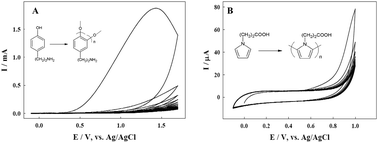An effective and robust electrochemical approach has been developed for selective detection of dopamine in the presence of 3,4-dihydroxyphenylalanine (L-DOPA), ascorbic acid, uric acid and other dopamine metabolites. A ‘layer-by-layer’ film of tyramine and pyrrole-1-propionic acid (PPA) was formed by subsequent electropolymerization on a boron-doped diamond (BDD) electrode with an overall thickness of ∼33 nm as estimated by AFM. The formation of the electropolymerized homogeneous film was also confirmed by SEM and Raman spectroscopy. The modified BDD electrode exhibited rapid response to dopamine within 6 s and a detection limit of 50 nM with excellent reproducibility. The stable electropolymerized film was capable of excluding electroactive interference from 20 µM L-DOPA, 20 µM 3,4-dihydroxyphenylacetic acid (DOPAC), and ascorbic and uric acids at normal physiological conditions (100 µM each). The modified electrode could be used for several repeated analyses of dopamine at 5 µM, without noticeable surface fouling. A plausible mechanism for permselectivity was suggested and supported by pertinent experimental data.

You have access to this article
 Please wait while we load your content...
Something went wrong. Try again?
Please wait while we load your content...
Something went wrong. Try again?


 Please wait while we load your content...
Please wait while we load your content...